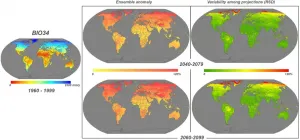(Press-News.org) The sun is the only star in our system. But many of the points of light in our night sky are not as lonely. By some estimates, more than three-quarters of all stars exist as binaries -- with one companion -- or in even more complex relationships. Stars in close quarters can have dramatic impacts on their neighbors. They can strip material from one another, merge or twist each other's movements through the cosmos.
And sometimes those changes unfold over the course of a few generations.
That is what a team of astronomers from the University of Washington, Western Washington University and the University of California, Irvine discovered when they analyzed more than 125 years of astronomical observations of a nearby stellar binary called HS Hydra. This system is what's known as an eclipsing binary: From Earth, the two stars appear to pass over one another -- or eclipse one another -- as they orbit a shared center of gravity. The eclipses cause the amount of light emitted by the binary to dim periodically.
On Jan. 11 at the 237th meeting of the American Astronomical Society, the team reported more than a century's worth of changes to the eclipses by the stars in HS Hydra. The two stars began to eclipse in small amounts starting around a century ago, increasing to almost full eclipses by the 1960s. The degree of eclipsing then plummeted over the course of just a half century, and will cease around February 2021.
"There is a historical record of observations of HS Hydra that essentially spans modern astronomy -- starting with photographic plates in the late 19th century up through satellite images taken in 2019. By diving into those records, we documented the complete rise and fall of this rare type of eclipsing binary," said team leader James Davenport, a research assistant professor of astronomy at the UW and associate director of the UW's DIRAC Institute.
The eclipses of the two stars that make up HS Hydra are changing because another body -- most likely a third, unobserved companion star -- is turning the orientation of the binary with respect to Earth. Systems like this, which are called evolving eclipsing binaries, are rare, with only about a dozen known to date, according to Davenport. Identifying this type of binary requires multiple observations to look for long-term changes in the degree of dimming, which would indicate that the orientation of the binary is changing over time.
HS Hydra has such an observational record because, at 342 light- years away, it is a relatively close and bright system and the two stars orbit each other every 1.5 days. Scientists first reported that HS Hydra was an eclipsing binary in 1965. In a 2012 paper, astronomers based in Switzerland and the Czech Republic reported that the amount of dimming from HS Hydra decreased from 1975 through 2008, indicating that the two stars were eclipsing smaller and smaller portions of one another over time. That team also predicted that the eclipses would end around 2022.
Davenport and his team checked in on HS Hydra using observations of the system in 2019 by the NASA's Transiting Exoplanet Survey Satellite, or TESS. They saw only a 0.0075-magnitude drop in light from HS Hydra, a sign that the two stars were barely covering one another during eclipses. For comparison, eclipses in 1975 saw a more than 0.5-magnitude drop.
"Fifty years ago, these two stars were almost completely eclipsing each other. By the early 21st century, the degree of eclipse was around 10%, and in the most recent observations from 2019, they barely overlapped," said Davenport.
With these new data, the team now predicts that HS Hydra eclipses will cease around February 2021.
The observations from the 1960s through 2019 catalogue the decline of HS Hydra as an evolving eclipsing binary. But Davenport and his team also uncovered evidence for its rise. The Digital Access to a Sky Century at Harvard, or DASCH, is a digital catalog of photometric data taken from more than a century's worth of astro-photographic plates at Harvard University. The team mined this record and found observations of HS Hydra from 1893 through 1955 that they could analyze to search for signs of dimming.
The researchers broke down DASCH observations of HS Hydra by decade. From the late 19th century through the roaring '20s, HS Hydra showed no measurable dimming. But things began to change in the 1930s, where they measured a modest 0.1-magnitude drop in brightness. The degree of dimming rose through the 1940s and peaked in the 1950s with a 0.5-magnitude drop in brightness.
Based off this 126-year history of HS Hydra observations, the team predicts that the system will start eclipsing again around the year 2195. But, that assumes that the third companion -- which other teams have predicted is a small, dim M-dwarf star -- continues to behave as it has to date.
"We won't know for sure unless we keep looking," said Davenport. "The best we can say right now is that HS Hydra has been changing constantly over the course of modern astronomy."
Missions like TESS will likely identify more evolving eclipsing binaries in the coming years. This should open new opportunities for astronomers to understand how star systems are built, as well as how they change over time -- whether they are busy, dynamic systems like HS Hydra, or more quiet systems, like ours.
INFORMATION:
Co-authors on the paper are UW graduate students Diana Windemuth and Jessica Birky; UW researcher Karen Warmbein; Erin Howard at Western Washington University; and Courtney Klein at UC Irvine. The research was funded by NASA, the National Science Foundation, the Heising-Simons Foundation, the Research Corporation for Science Advancement, the DIRAC Institute, the UW Department of Astronomy, the Charles and Lisa Simonyi Fund for Arts and Sciences and the Washington Research Foundation.
For more information, contact Davenport at jrad@uw.edu.
References:
* "The Rise and Fall of a Remarkable Eclipsing Binary Star," presented by James Davenport (University of Washington), AAS 237, Jan. 11, 2021, Session 133.06 (Binary Stellar Systems I)
* AAS press conference "Evolving Stars & Nebulae I," Thursday, Jan. 14, 2021 at 4:30 p.m. U.S. Eastern Time (1:30 p.m. U.S. Pacific Time)
Grant numbers: NSF BPC-A #1246649, NSF DGE-1839285, NSF DGE-1762114, NSF AST-0407380, NSF AST-0909073, NSF AST-1313370.
There's a 7-fold unexplained variation in rates of euthanasia across The Netherlands, reveals an analysis of health insurance claims data, published online in the journal BMJ Supportive & Palliative Care.
It's not clear if these differences relate to underuse, overuse, or even misuse, say the researchers.
The Netherlands was the first country in the world to legalise euthanasia and physician-assisted suicide, introducing preliminary legislation in 1994, followed by a fully fledged law in 2002. The practice has been tolerated, however, since 1985.
Official data show that the number of euthanasia cases has risen more or less continuously since 2006, reaching 6361 in 2019. These cases ...
Climate change impacts, affecting primarily ecosystems' functions and consequently human sectors, have become a crucial topic. Observed and expected variations in climate conditions can in fact undermine the ecosystems' ecological equilibrium: average climate patterns, mainly represented by intra-annual (monthly to seasonal) temperature and precipitation cycle, directly influence the distribution, abundance and interactions of biological species.
During the long history of scientific research on the relationships between climate and Earth's communities, ...
BIRMINGHAM, Ala. - Use of the diabetes drug metformin -- before a diagnosis of COVID-19 -- is associated with a threefold decrease in mortality in COVID-19 patients with Type 2 diabetes, according to a racially diverse study at the University of Alabama at Birmingham. Diabetes is a significant comorbidity for COVID-19.
"This beneficial effect remained, even after correcting for age, sex, race, obesity, and hypertension or chronic kidney disease and heart failure," said Anath Shalev, M.D., director of UAB's Comprehensive Diabetes Center and leader of the study.
"Since similar results have now been obtained in different populations from around the world -- including China, France and a UnitedHealthcare analysis -- this suggests that the ...
Ignoring a colleague's greeting or making a sarcastic comment in the workplace may actually do more harm than intended, according to West Virginia University research.
Perceived low-grade forms of workplace mistreatment, such as avoiding eye contact or excluding a coworker from conversation, can amplify suicidal thoughts in employees with mood disorders, based on a study by Kayla Follmer, assistant professor of management, and Jake Follmer, assistant professor of educational psychology.
"We know from prior research that minor forms of workplace mistreatment reduce employee engagement," Kayla Follmer said. "But our paper provided an explanation for ...
New York, NY (January 14, 2020) -- Girls who are emotionally neglected or severely sexually abused early in their lives report riskier sexual behaviors during adolescence, Mount Sinai researchers report. The findings highlight the need--and suggest the potential for tailored approaches--to promote healthy sexual development in vulnerable populations.
The researchers identified four distinct patterns of neglect and sexual abuse in low-income, predominantly Black and/or Latina girls and young women that led to distinct trajectories of risky sexual behavior during adolescence. Their findings were published in Child Development in January.
The study was the first of its kind to identify categories of maltreatment among adolescent girls of color in an urban setting that correspond with measurable ...
The COVID-19 pandemic, which claimed more than 336,000 lives in the United States in 2020, has significantly affected life expectancy, USC and Princeton researchers have found.
The researchers project that, due to the pandemic deaths last year, life expectancy at birth for Americans will shorten by 1.13 years to 77.48 years, according to their study published Thursday in the Proceedings of the National Academy of Sciences.
That is the largest single-year decline in life expectancy in at least 40 years and is the lowest life expectancy estimated since ...
A team of biophysicists from the University of Massachusetts Amherst and Penn State College of Medicine set out to tackle the long-standing question about the nature of force generation by myosin, the molecular motor responsible for muscle contraction and many other cellular processes. The key question they addressed - one of the most controversial topics in the field - was: how does myosin convert chemical energy, in the form of ATP, into mechanical work?
The answer revealed new details into how myosin, the engine of muscle and related motor proteins, transduces energy.
In the end, their unprecedented research, meticulously ...
Humans, mammals and birds that live in a particular environment share a common set of behavioral traits, according to a new study, which identifies a local convergence of foraging, reproductive and social behaviors across species. The findings, based on studying more than 300 small-scale human hunter-gatherer populations, support one of the central tenets of human behavioral ecology - that ecological forces select for various behaviors in distinct environments, driving behavioral diversity worldwide. The origin and evolution of human behavior are uncertain and debated. While some suggest ...
The volatile plant hormone ethylene allows plant roots to sense and avoid compacted soils, researchers report. Rendering roots insensitive to ethylene allowed them to penetrate compacted soils more effectively, the same group showed. The findings reveal how plants regulate their growth in response to soil compaction - a growing challenge facing modern agriculture worldwide - and could serve as a pathway for how breeders might select or develop new crops resilient to soil compaction. Driven in part by a growing reliance on heavy machinery and poor soil management practices, soil compaction can lead to declining crop yields by restricting root growth and limiting the availability ...
A large class of mammalian genes is not completely shared throughout sperm development and differentiation, according to a new study of sperm in organisms including mice, macaques and men. The findings provide an explanation to why testis gene expression patterns often appear as an outlier relative to all other tissues. In mammals, spermatogenesis includes a long stage of haploid gene expression, which could lead to variation between individual sperm cells, resulting in sperm-level natural selection and trait inheritance. However, during differentiation, maturing haploid spermatids ...




